Of particular significance is the fact that the average age of the participants was somewhere between 25 and 30 years. In my opening speech I made the point that given the downward trend of that number, soon we will be running a kindergarden. But nobody laughed - these kiddos are serious about machine learning, and they showed it with the excellent quality of the material they presented.
We had over 40 presentations and 12 posters, plus three great keynote talks delivered by Danilo Rezende (Deep Mind), Riccardo Zecchina (Univ. Bocconi) and Andrea Walther (Univ. Berlin). The workshop was organized in six sessions, covering the bulk of our core business: besides a session on specific aspects of computer science connected with the theme of the workshop, there were sessions on particle physics, astroparticle physics, nuclear and neutrino physics, muography, and medical physics applications.
The idea at the source of this series of workshop comes from yours truly, who six years ago realized that after the 2012 revolution (AlexNet and the rise of machine learning), physicists had duly started to employ more and more refined and powerful techniques in their analysis tasks, but there was a huge void to be filled - detectors were still being designed using very old paradigms and preconceptions, without any support from new computer science tools.
If finding the best combination of 50 discriminating variables in the task of selecting a Higgs boson signal from background looks like a superhuman, CPU-prohibitive task (the 50-dimensional space of those variables is impervious to human exploration or even by point-by-point scanning) that nowadays deep learning can solve for us, think at the task of choosing the geometrical layout of a detector of the complexity of ATLAS or CMS. The space of design choices there is O(10,000) dimensional. Can we do it by hand? Nope. Can we ever believe that experience and intuition may guide our hand toward finding the best choice, maybe with the help of a high-fidelity simulation of a handful of selected test designs? Nope.
Instead, gradient descent techniques (and in some cases, evolutionary search algorithms) provide the possibility to fully scan the parameter space, if you model your problem with a set of differentiable programming modules that simulate the full experiment - its layout, the data generation processes, the pattern recognition and inference extraction procedures.
So I founded a collaboration (MODE, for Machine-Learning Optimization of the Design of Experiments) to collect researchers in fundamental science and computer scientists interested in proving the idea of end-to-end modeling and optimization of these giant, super-complex machines. Together with a few colleagues, we reasoned that if we could prove that our technology could find innovative, much more performant (and often cheaper) solutions in the analysis of simple use cases, we would be slowly convincing more colleagues that ours was the way to go in attacking more complex problems. In the meantime, assembling a library of solutions would allow us to simplify and expedite the time-to-solution for new tasks, as many of the problems share parts of the computing pipelines (the physics processes, the pattern recognition, the inference).
It is impossible for me to summarize here the large amount of great work I heard in Valencia last week, but if you are interested you can freely access the talks and posters at this site. Here I will just mention the work presented there by my students.
1) Optimization of an electromagnetic calorimeter for the muon collider: Federico Nardi
Federico is a Ph.D. student who works under the joint supervision of Julien Donini (UCA) and myself. He is attacking the problem of finding the best configuration of a calorimeter that will operate in a future muon collider, where muons decay in the beam and produce a huge lateral flux of backgrounds (mostly soft photons and neutrons) which cannot be properly shielded, and must be reckoned with when defining the geometry of the detector, which needs to preserve high resolution in measuring high-energy photons from Higgs boson decays. Since such a task is strongly dependent on the particular reconstruction method you use for the identification of the photon clusters, you cannot lay down an end-to-end modeling pipeline that includes a sloppy method for energy measurement. So he used a powerful object condensation method developed for the task by Jan Kieseler, and showed it outperforms other reconstruction methods. He then modeled with differentiable surrogates the fluxes of energy in the calorimeter from signal and background, and he is now putting all blocks together to search for the best geometry of the calorimeter cells.
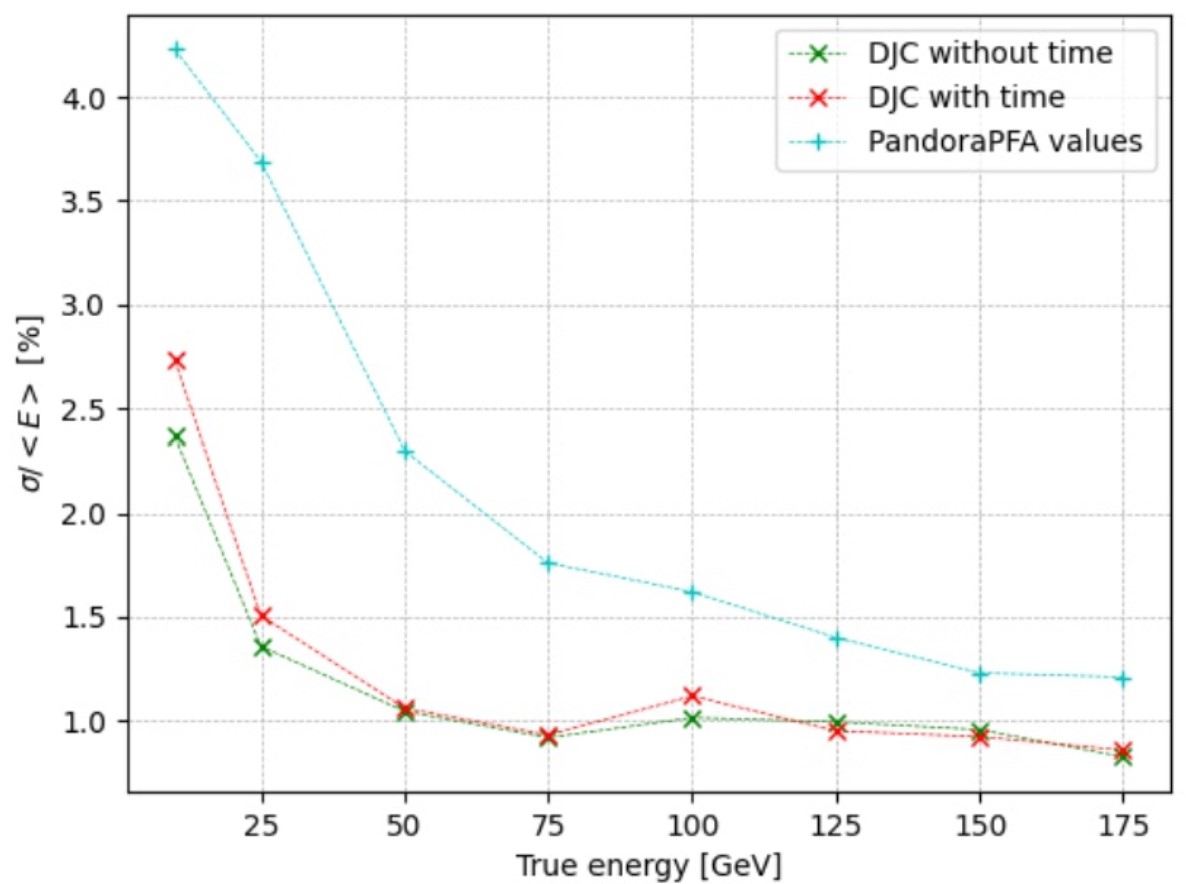
Above, a graph showed by Federico. The two lower curves are the result of the object condensation reconstruction on the relative energy resolution as a function of the energy of photons. The light blue curve is the standard result presently used by simulations of the muon collider collaborations.
2) Tracking charged particles with a neuromorphic system: Emanuele Coradin
Emanuele is a master student in Padova, and he works with me and a small group that includes Fabio Cufino (another master student in Bologna/Dortmund/Clermont Ferrand), the neuromorphic computer expert from Lulea prof. Fredrik Sandin, and a few other students. The idea here is to prove that a spike-time dependent plasticity model of neurons connected in a network can make sense of hits produced by particles in the CMS tracker and identify tracks of different momenta in the presence of large noise contributions, in a completely unsupervised manner. This would foster applications to particle physics of these systems, particularly in the triggering of signals and fast data collection. He showed the architecture of a spiking neural network model that receives information on the position of hits in the form of the time of arrival of spikes to synapses. After seeing a few tens of thousand tracks and background events, the network starts firing only when tracks are present, with high efficiency (>95%) and fake background (<5%). The challenge is now to make the output neurons more selective in identifying particles of different momenta.
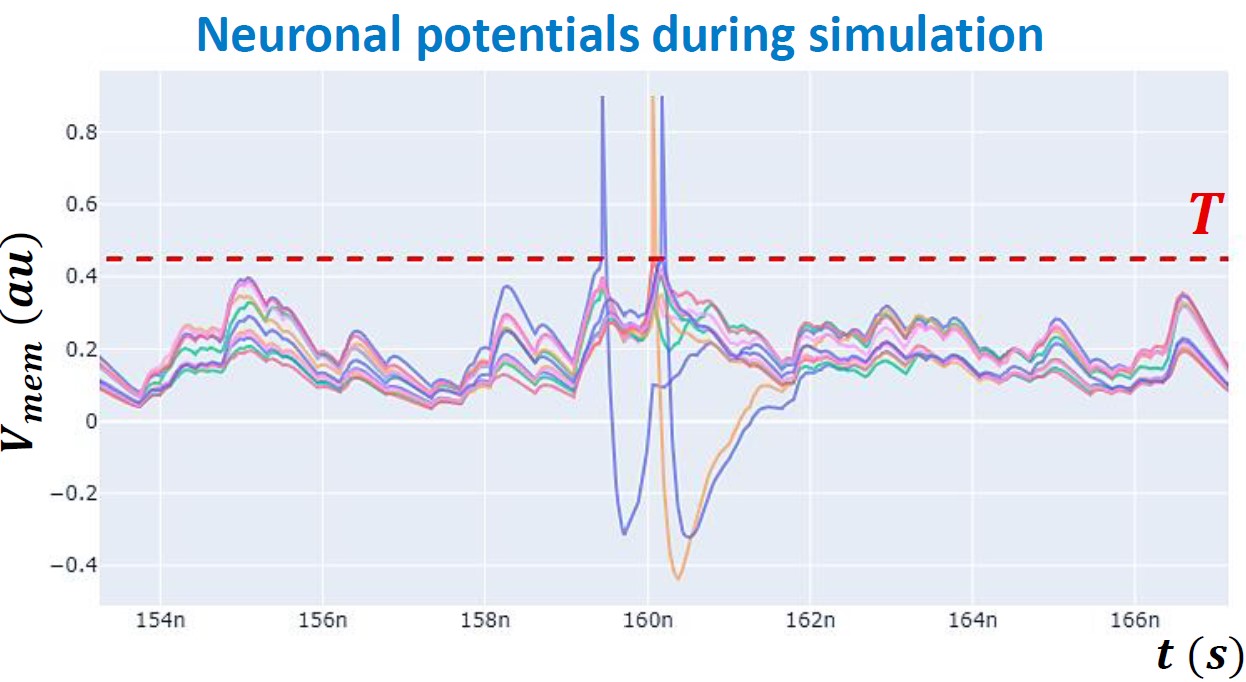
Graph showing the time evolution of neuron potentials while they acquire spikes from their synapses. When neurons reach a potential indicated by the dashed line, they produce an output spike and become refractory for a short period of time.
3) Particle ID in a granular calorimeter: Andrea de Vita
Andrea (who is also working with a group of other students, see their names in the poster) used GEANT4 simulations of a very high-granularity calorimeter block (of 100x100x100 small cells) to prove that it is possible to distinguish the signal left by protons, pions, and kaons of high energy, based solely on the topology of the energy depositions and their time of arrival. He cunningly constructed 49 variables that summarize the observed patterns, and proved a 63% discrimination of protons from pions, and also a significant three-class discrimination of the three particle species. After some further tuning and optimization of the discrimination, the work will focus on understanding at what cell size this information gets lost - so that we know how to build our calorimeters in the future.
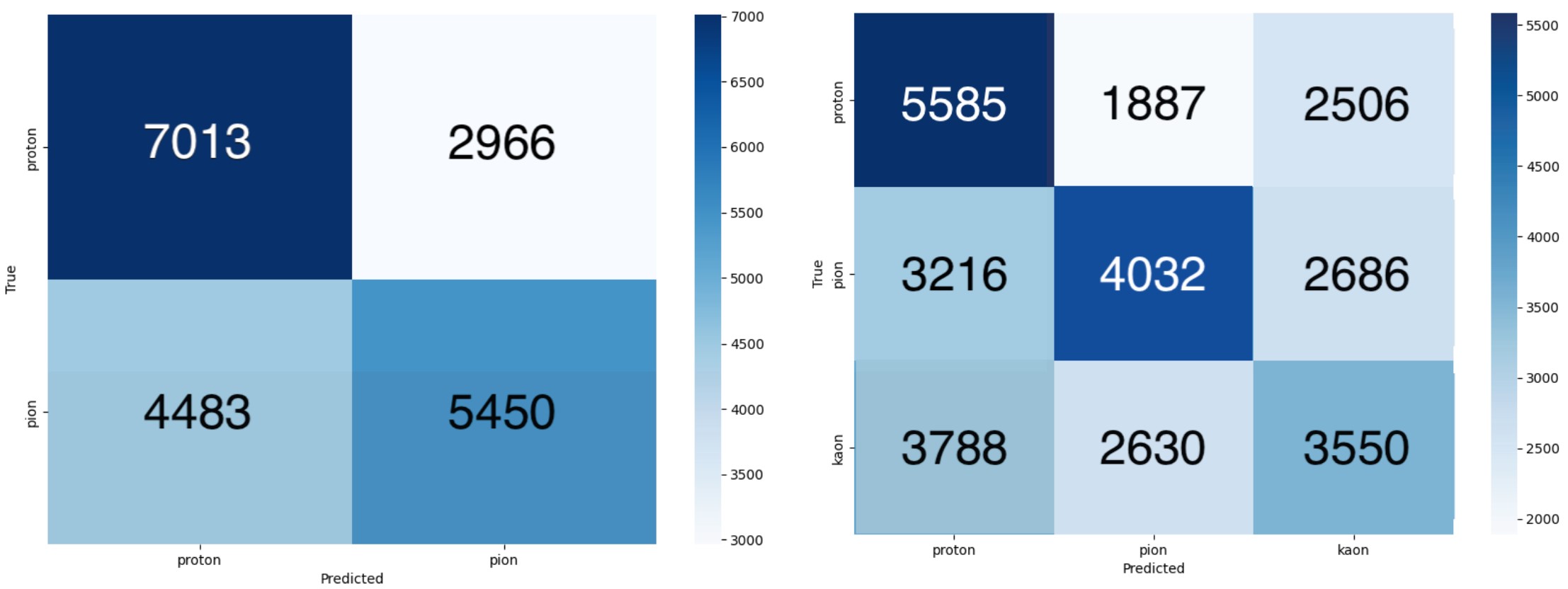
Above: two-class (proton/pion, left) and three-class (proton/pion/kaon, right) confusion matrix from the classification task.
4) High-granularity neuromorphic readout of a hadron calorimeter: Enrico Lupi
Does reading out millions of cells in a hadron calorimeter sounds like overkill? We are already studying an alternative solution. if the particle ID task described at point 3 above cannot be done by segmenting and separately reading out millions of individual scintillator cells, we can couple scintillator blocks of larger size with nanowire chips, which receive the light produced by the scintillator and perform a preprocessing of the information, naturally time-encoded by the arrival time of the produced photons. Nanowires can directly absorb those photons and re-emit them in specific directions; they also can be inhibited to re-emit light in particular circumstances, such that several layers of these devices can act like a neuromorphic system of neurons, and perform calculations in real time, producing useful primitives that can be sent to the back end. The beauty of this is that it works entirely with photons, so it is very fast and energy-effective. Enrico showed how he produced the data in the form of trains of photons in different points of the side of the scintillator block. Looking at the gif of interactions evidences how there indeed is a large amount of information we can mine there!
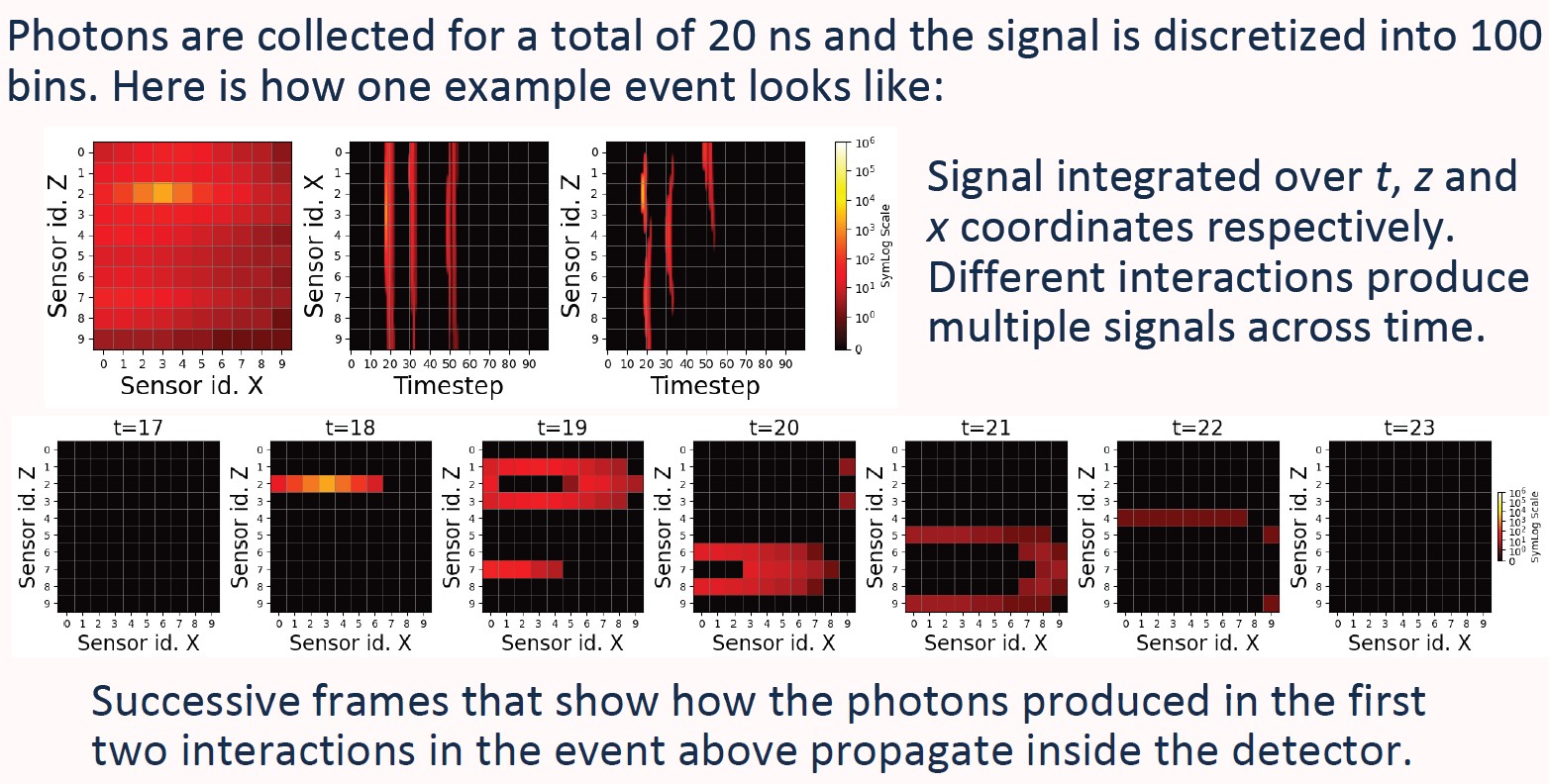
Above: a figure from Enrico's poster showing the integrated light signal as seen in the zx side of a scintillator block (top left), the time succession of the light arrival as a function of x and z (top center and right) and the xz view of photon signals as a function of time (in six successive 200ps steps).
5) Differentiating GEANT4: Xuan-Tung Nguyen
Xuan-Tung is a master graduate who is presently working with me and Nico Gauger and Max Aehle at RPTU Kaiserslautern, where the task of creating a differentiable version of the GEANT4 simulation is in progress. Of course GEANT4 is a gigantic piece of code, but bit by bit it is possible to find ways to compute the derivatives of the simulated processes, which would eventually allow to include the full simulation of particle interactions with matter in a differentiable program. Xuan-Tung showed how this can be done for the energy and position derivatives for electromagnetic particle interactions for now. He will next target the interaction of single hadrons.
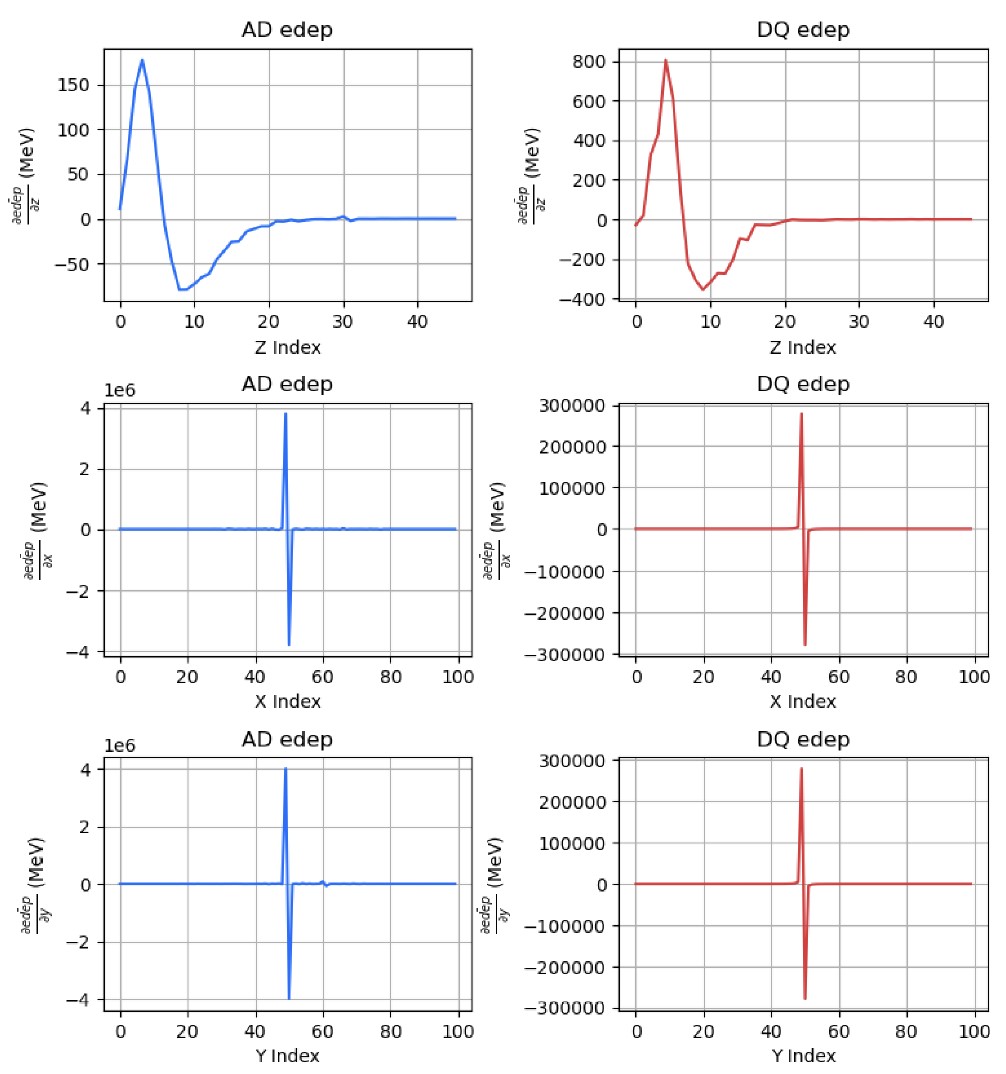
Above: comparison of derivatives of the energy deposition with respect to spatial coordinates (z,x,y in the three rows) computed with automatic differentiation (left) and numerically (right).
6) Triggering on neutrinos in ice with neuromorphic computing: Alexander Kyuroson
Alexander is a master student at Lulea University of Technology, where he works under the supervision of Fredrik Sandin and the collaboration of myself and of Christian Glaser in Uppsala. We are looking at the tough problem of reading out the electromagnetic signal produced by antennas planted in the ice sheet of the north pole, which may detect pulses when ultra-energetic neutrinos interact in the underlying ice. Due to the power limitations, this continuous reading and triggering task is best performed with neuromorphic chips. Alexander showed a very complex, novel hybrid architecture that is capable of finding the best parameters of a neuromorphic system reading out the impulses through evolutionary optimization.
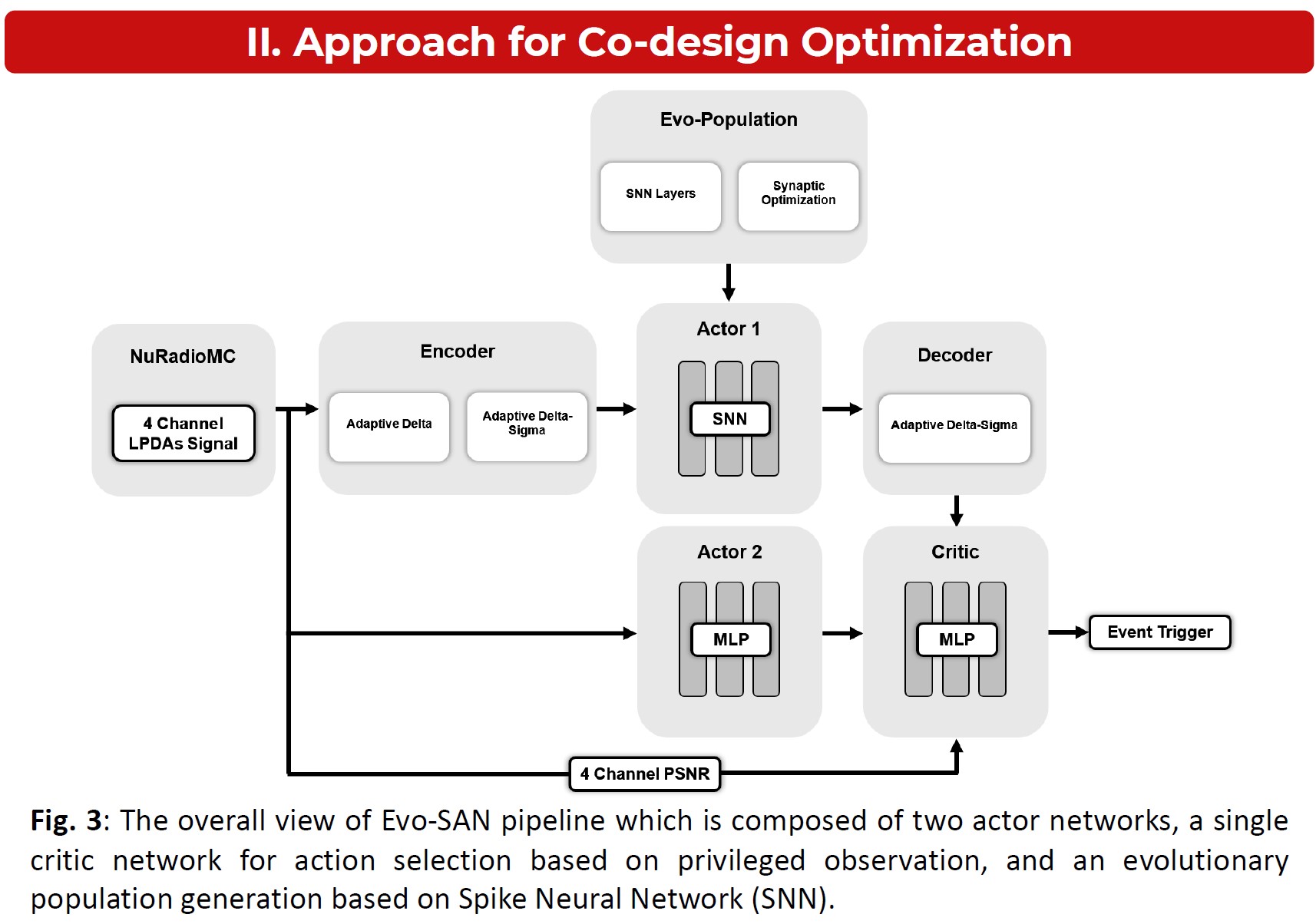
Above, a flux diagram from Alexander's poster. Note the SNN block, which is trained in forward mode only, but optimized by evolutionary resampling.
7) Finding new materials for memristors: Muhammad Awais
Awais is a Ph.D. student we recently hired with a joint position between INFN-Padova and Lulea University of Technology to study neuromorphic solutions for particle detectors. As Awais in his previous studies has become an expert in materials science, we are exploiting his skills in investigating possible solutions for the construction of memristors. Memristors are devices that can store information in the resistive properties of specific materials. They can thus be a great solution for the substrate of neuromorphic processors. Awais showed results of calculations of the band gaps of two different materials that had previously not been studied, one of which shows promising properties for the fabrication of these devices.
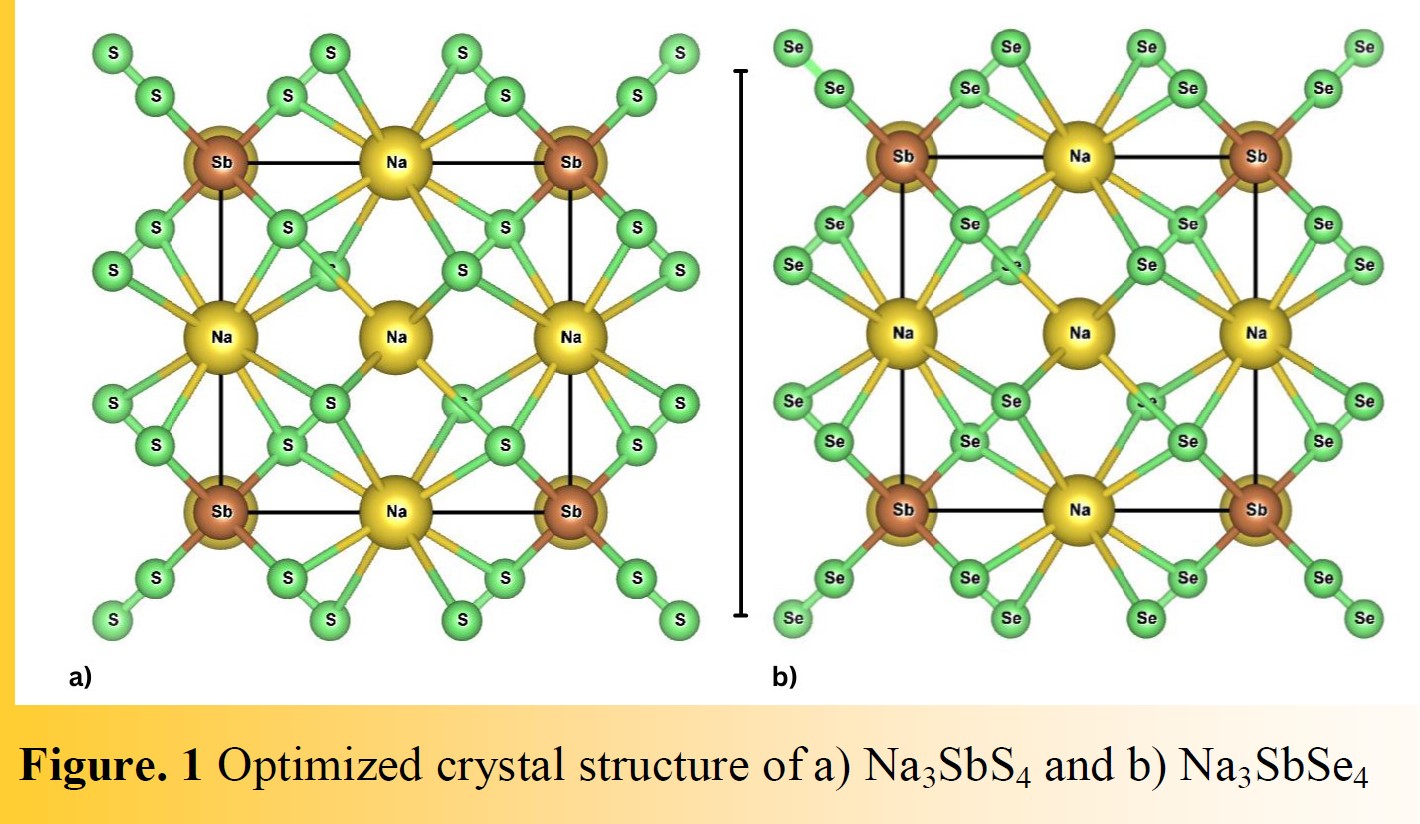
Above: the optimized crystal structure of the two compounds studied in Awais' poster.
Andrea de Vita won the first prize for the best poster, and Alexander Kyuroson won the second prize. Congratulations to both! But all posters and talks of my students were great, so congratulations to all!




Comments